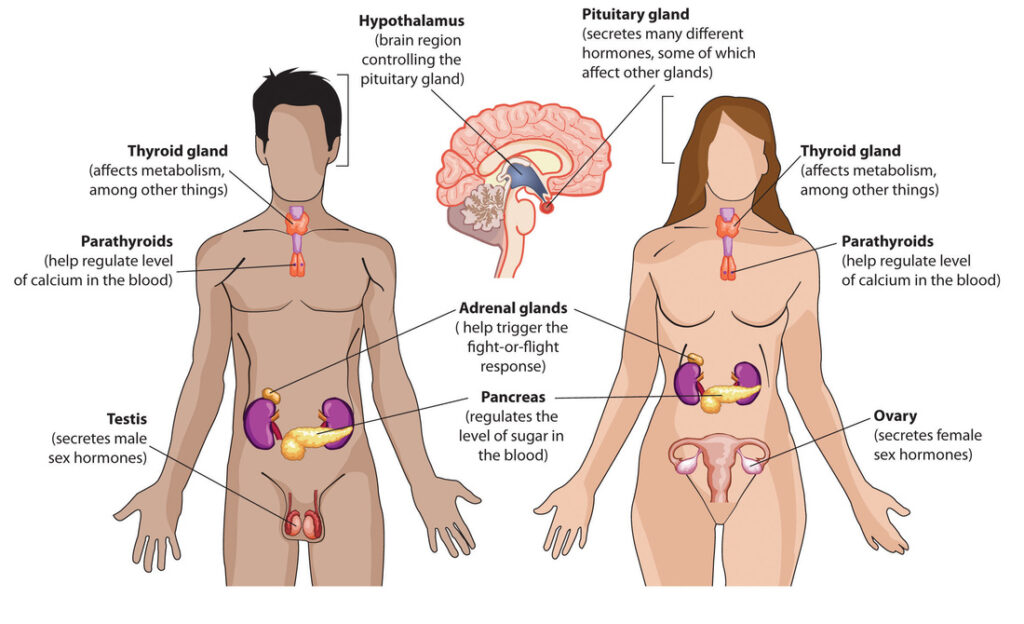ENDOCRINE SYSTEM

The endocrine system is comprised of a collection of specialized bodily tissues that are responsible for the production, storage, and secretion of hormones. Hormones are the chemical messengers that are produced by the body.
Hormones are messengers that relay information from one group of cells to another. The endocrine system is responsible for a great deal of the body’s behavior and function.
The regulation of the body’s rate of growth and development is one of the endocrine system’s many roles and responsibilities.
The endocrine system is responsible for a variety of processes, including supporting reproductive functions, controlling metabolism, and affecting the function of numerous tissues.
Because endocrine glands do not have ducts that connect them to other areas of the body, endocrine organs are also referred to as ductless glands. The hormones that they produce are then delivered into circulation in a direct manner.
The pituitary gland, the hypothalamus, the adrenal glands, the parathyroid glands, the thyroid gland, the pineal gland, and the reproductive organs together make up the endocrine system (ovaries and testes).
This is the hypothalamus.
This gland can be found deep in the cerebral cortex. It is in charge of regulating the functioning of the endocrine system. Because it is responsible for coordinating activity between the brain and the pituitary gland, the hypothalamus serves as the primary connection point between the neurological system and the endocrine system.
That gland in the pituitary
At the very bottom of the brain is where you’ll find the pituitary gland. Because it produces hormones that control the activity of other endocrine glands, it plays a highly significant part in the body’s overall functioning.
There are two distinct parts of the pituitary gland (the anterior and posterior lobes). Each one is responsible for a different task.
The thyroid, adrenal, and reproductive glands are all under the authority of the anterior lobe. It is in charge of regulating a woman’s growth as well as the production of milk while she is breastfeeding her child. The following are examples of hormones that are produced by the anterior lobe:
Adrenocorticotropic hormone
Thyroid-stimulating hormone
Luteinizing hormone
FSH, also known as follicle-stimulating hormone (FSH )
Hormone regulating growth
A hormone known as prolactin
Endorphins
The back part, or posterior lobe
Antidiuretic hormones are secreted by the posterior lobe of the pituitary gland, which is responsible for regulating the body’s overall water balance.
In addition to this, it causes the synthesis of oxytocin, a hormone that helps regulate muscle contractions during labor and lactation.
This gland is the thyroid.
In the neck is where you’ll find your thyroid gland. When activated by the pituitary gland, it secretes hormones into the bloodstream. The thyroxine and three-iodothyronine that are secreted by the thyroid gland are what regulate the growth and metabolism of the organism.
Those glands are known as the parathyroids
There are four glands that make up the parathyroid system, and they can be located in the thyroid gland’s four corners. They are responsible for the production of a hormone known as parathyroid, which regulates the calcium content of the blood.
Hormones are produced by the reproductive organs of both males and females, specifically the testes in males and the ovaries in females.
Testicles produce testosterone, which is responsible for the development of male features in appearance (muscular body, facial hair, deeper voice, etc.).
Ovaries are responsible for the development of female features due to their production of estrogen and progesterone (broad hips, breasts, menstrual cycle).
On top of each kidney is where one will find the adrenal gland. It also prepares the body to deal with stress by secreting hormones that regulate metabolism, the balance of water and salts, and other bodily functions.
The adrenal gland’s primary function is the production of adrenaline, which is the hormone most commonly referred to as the “fight or flight” hormone. In order to prepare the body for a fight or flight response, adrenaline speeds up the heart rate and increases blood flow.
The gland of the pineal lobe
In the exact middle of the brain is where you’ll find the pineal gland. Melatonin is a hormone that is produced by the pineal gland, which is responsible for regulating the wake-sleep cycle.
It is the pancreas.
In addition to its role in digestion, the pancreas also secretes hormones into the bloodstream. Insulin and glucagon, two hormones that regulate sugar levels in the blood, are secreted by this organ.



